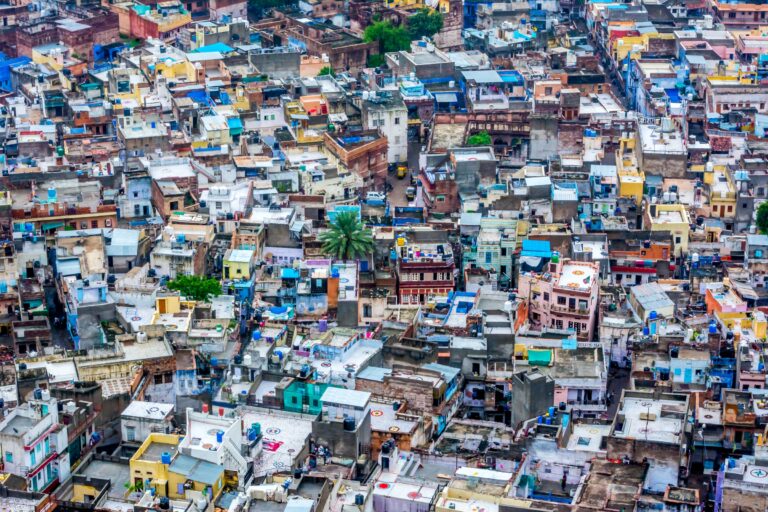On the surface, India’s story of growth and its triumphs over poverty are enviable. India’s income per capita has increased fourfold in the last two decades, and its absolute poverty – measured on the international poverty line – reduced sharply from 40 per cent in 2000 to 13.4 per cent in 2015.
Deeper analysis supports this, but shows that while India is no longer chronically poor, its growth has not been inclusive. The segment of the population that ‘graduated’ from poverty is largely still vulnerable, with consumption levels very close to the poverty line, and far from becoming a ‘middle class’.
Poverty is concentrated in a few states that house 45 per cent of India’s population but 62 per cent of its poor, and vulnerable groups that risk slipping back to absolute poverty include women, scheduled tribes, informal workers, and inter-state migrants.
The share of national income held by the top 10 per cent has been steadily increasing in India and was at 55 per cent in 2015 – the highest in the world. The top 10 per cent of the Indian population holds 77 per cent of the total national wealth.
These numbers are only becoming even more extreme. In 2017, 73 per cent of wealth generated in India went to the richest one per cent, while 67 million Indians at the bottom of the wealth latter saw their wealth increase by just one per cent.
So what should Indian policymakers do? India’s Prime Minister Narendra Modi’s belief that wealth must be created before being distributed has been largely reflected in his government’s tax policies. They are broadly aimed at overcoming newly sluggish economic growth, but have failed to make growth inclusive.
In 2015, the government did away with wealth tax on the premise that its collection was inefficient and later introduced surcharges on high-income earners instead.
While efficiency is a valid concern, the choice of taxing income over wealth is problematic for India – a country where four out of 10 billionaires inherit their wealth – particularly as it already abolished inheritance taxes in 1985.
On top of this, the corporate tax rate was reduced last year from 30 per cent to 22 per cent, ostensibly to boost foreign direct investment and provide incentives for creating jobs. However, this has not translated into gains for ordinary people. Economists have termed India’s rise ‘jobless growth’ because the amount of jobs created trails behind the country’s economic growth.
Additionally, the majority of jobs generated have been in the informal sector, which does not guarantee a minimum wage or provide insurance.
In 2020, income tax rates have been reduced to drive consumption. But in a country with such a large number of people engaged in informal work and only a small number of workers falling within the income tax bracket, an income tax reduction benefits only very few Indians.
The World Bank estimates direct taxes to decline in the next year, mainly due to corporate tax cuts, whereas indirect taxes are expected to grow in comparison.
This reliance on indirect taxes is regressive and restricts redistribution and inclusive growth, and India must step away from it.
Furthermore, with the added stress of the pandemic, the fiscal deficit, sitting already at 4.6 per cent, is further projected to increase. This will surely create a squeeze that could damage much-needed investments in health, education, and infrastructure.
India’s tax levels are already low compared to other emerging markets, and it needs to focus on a fairer distribution of wealth, not cutting tax further. The International Monetary Fund recommends a combination of higher marginal tax rates on top income earners, capital tax, corporate tax, and various forms of wealth tax to increase progressivity. This is a path India must consider carefully.
More broadly, Indian policymakers should question the logic of reduced corporate taxes resulting in higher investment. Evidence suggests that rather than simply the size of corporate tax levels, investors are more concerned about the investment climate of a country, including its institutions, governance mechanisms, and certainty about taxation regimes.
India could also reconsider a combination of wealth taxes, such as recurrent taxes on property or net wealth, transaction taxes, land taxes, and inheritance and gift taxes to make its tax structure more progressive.
That said, the problems with taxing net wealth other countries have experienced should be a lesson for India. Expansion of the net wealth tax base often does not translate to higher wealth tax revenues where regulations are not strongly functioning. By not updating property values, tax evasion, or engaging in other avoidance behaviour, the very rich can largely escape paying their fair share. Still, rather than using this as an excuse to discard wealth tax altogether, India should focus on improving its administration and the enforcement of tax collection to increase the revenue from such taxes.
Overall, it will take a combination of tax policy measures for India to step towards more inclusive growth. After all, there is no point in economic growth that comes at the cost of pushing the vulnerable ever further into poverty.
First published at Policy Forum on Thursday 5 November 2020.





Recent Comments